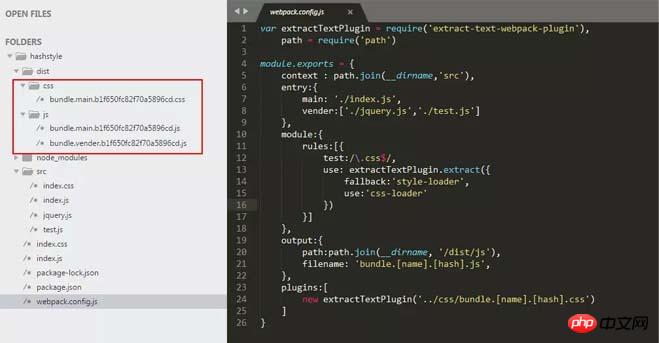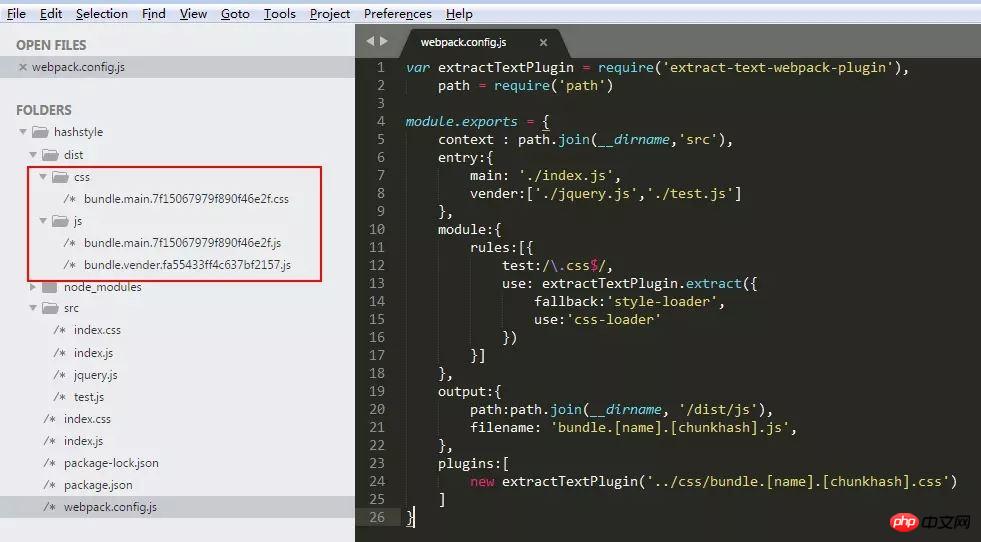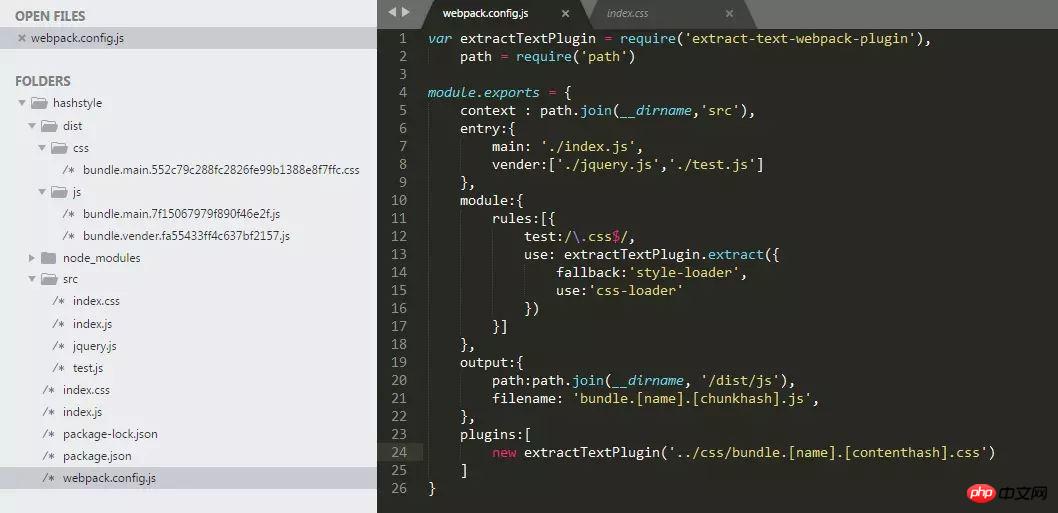 Web Front-end
Web Front-end
 JS Tutorial
JS Tutorial
 Sharing the differences between hash, chunkhash and contenthash in webpack
Sharing the differences between hash, chunkhash and contenthash in webpack
Sharing the differences between hash, chunkhash and contenthash in webpack
This article mainly introduces the detailed explanation of the differences between hash, chunkhash, and contenthash in webpack. It also introduces the usage and difference of hash, chunkhash, and contenthash in detail. Those who are interested can learn about it. I hope it can help everyone.
hash, chunkhash, contenthash
hash is generally used in conjunction with CDN caching. After being built through webpack, the corresponding file name is automatically generated with the corresponding MD5 value. If the file content changes, the corresponding file hash value will also change, and the URL address referenced by the corresponding HTML will also change, triggering the CDN server to pull the corresponding data from the source server, and then update the local cache. However, in actual use, there are still certain differences between these hash calculations.
Let’s first build a test case to simulate:
Project structure
Our project structure is very simple, the entry file index.js references index.css. Then jquery.js and test.js were created as public libraries.
//index.js
require('./index.css')
module.exports = function(){
console.log(`I'm jack`)
var a = 12
}//index.css
.selected : {
display: flex;
transition: all .6s;
user-select: none;
background: linear-gradient(to bottom, white, black);
}Then we modify webpack.config.js to simulate different hash calculations
hash
hash is related to the construction of the entire project, as long as the project If there are file changes, the hash value of the entire project build will change, and all files share the same hash value
var extractTextPlugin = require('extract-text-webpack-plugin'),
path = require('path')
module.exports = {
context : path.join(__dirname,'src'),
entry:{
main: './index.js',
vender:['./jquery.js','./test.js']
},
module:{
rules:[{
test:/\.css$/,
use: extractTextPlugin.extract({
fallback:'style-loader',
use:'css-loader'
})
}]
},
output:{
path:path.join(__dirname, '/dist/js'),
filename: 'bundle.[name].[hash].js',
},
plugins:[
new extractTextPlugin('../css/bundle.[name].[hash].css')
]
}According to the above configuration, after we execute the webpack command, we can get the following results
Execution result 1 using hash calculation:

Execution result 2:

We can see that the hash values of the files generated by the build are all the same, so the hash calculation is related to the construction of the entire project. The hashes generated in the same build process are all the same
chunkhash
If hash calculation is used, the hash value generated after each build is different, even if the file content has not changed at all. There is no way to achieve the caching effect in this way. We need to change to another hash value calculation method, namely chunkhash.
Chunkhash is different from hash. It parses dependent files based on different entry files (Entry), builds corresponding chunks, and generates corresponding hash values. We separate some public libraries and program entry files in the production environment, package and build them separately, and then we use chunkhash to generate hash values. Then as long as we do not change the code of the public library, we can ensure that its hash value will not change Affected.
var extractTextPlugin = require('extract-text-webpack-plugin'),
path = require('path')
module.exports = {
...
...
output:{
path:path.join(__dirname, '/dist/js'),
filename: 'bundle.[name].[chunkhash].js',
},
plugins:[
new extractTextPlugin('../css/bundle.[name].[chunkhash].css')
]
}Execution result 1 calculated using chunkhash:


At this time, we can use the contenthash value in extra-text-webpack-plugin to ensure that even if the content of other files in the module where the css file is located changes, as long as the content of the css file remains unchanged, it will not be built repeatedly.
var extractTextPlugin = require('extract-text-webpack-plugin'),
path = require('path')
module.exports = {
...
...
output:{
path:path.join(__dirname, '/dist/js'),
filename: 'bundle.[name].[chunkhash].js',
},
plugins:[
new extractTextPlugin('../css/bundle.[name].[contenthash].css')
]
}

Webpack’s sharing of style processing
How to use webpack’s externals
Detailed explanation of the difference between webpack require.ensure and require AMD_javascript skills
The above is the detailed content of Sharing the differences between hash, chunkhash and contenthash in webpack. For more information, please follow other related articles on the PHP Chinese website!

Hot AI Tools

Undresser.AI Undress
AI-powered app for creating realistic nude photos

AI Clothes Remover
Online AI tool for removing clothes from photos.

Undress AI Tool
Undress images for free

Clothoff.io
AI clothes remover

Video Face Swap
Swap faces in any video effortlessly with our completely free AI face swap tool!

Hot Article

Hot Tools

Notepad++7.3.1
Easy-to-use and free code editor

SublimeText3 Chinese version
Chinese version, very easy to use

Zend Studio 13.0.1
Powerful PHP integrated development environment

Dreamweaver CS6
Visual web development tools

SublimeText3 Mac version
God-level code editing software (SublimeText3)

Hot Topics
 VUE3 Getting Started Tutorial: Packaging and Building with Webpack
Jun 15, 2023 pm 06:17 PM
VUE3 Getting Started Tutorial: Packaging and Building with Webpack
Jun 15, 2023 pm 06:17 PM
Vue is an excellent JavaScript framework that can help us quickly build interactive and efficient web applications. Vue3 is the latest version of Vue, which introduces many new features and functionality. Webpack is currently one of the most popular JavaScript module packagers and build tools, which can help us manage various resources in our projects. This article will introduce how to use Webpack to package and build Vue3 applications. 1. Install Webpack
 What is the difference between vite and webpack
Jan 11, 2023 pm 02:55 PM
What is the difference between vite and webpack
Jan 11, 2023 pm 02:55 PM
Differences: 1. The startup speed of the webpack server is slower than that of Vite; because Vite does not require packaging when starting, there is no need to analyze module dependencies and compile, so the startup speed is very fast. 2. Vite hot update is faster than webpack; in terms of HRM of Vite, when the content of a certain module changes, just let the browser re-request the module. 3. Vite uses esbuild to pre-build dependencies, while webpack is based on node. 4. The ecology of Vite is not as good as webpack, and the loaders and plug-ins are not rich enough.
 How to use PHP and webpack for modular development
May 11, 2023 pm 03:52 PM
How to use PHP and webpack for modular development
May 11, 2023 pm 03:52 PM
With the continuous development of web development technology, front-end and back-end separation and modular development have become a widespread trend. PHP is a commonly used back-end language. When doing modular development, we need to use some tools to manage and package modules. Webpack is a very easy-to-use modular packaging tool. This article will introduce how to use PHP and webpack for modular development. 1. What is modular development? Modular development refers to decomposing a program into different independent modules. Each module has its own function.
 How does webpack convert es6 to es5 module?
Oct 18, 2022 pm 03:48 PM
How does webpack convert es6 to es5 module?
Oct 18, 2022 pm 03:48 PM
Configuration method: 1. Use the import method to put the ES6 code into the packaged js code file; 2. Use the npm tool to install the babel-loader tool, the syntax is "npm install -D babel-loader @babel/core @babel/preset- env"; 3. Create the configuration file ".babelrc" of the babel tool and set the transcoding rules; 4. Configure the packaging rules in the webpack.config.js file.
 Use Spring Boot and Webpack to build front-end projects and plug-in systems
Jun 22, 2023 am 09:13 AM
Use Spring Boot and Webpack to build front-end projects and plug-in systems
Jun 22, 2023 am 09:13 AM
As the complexity of modern web applications continues to increase, building excellent front-end engineering and plug-in systems has become increasingly important. With the popularity of Spring Boot and Webpack, they have become a perfect combination for building front-end projects and plug-in systems. SpringBoot is a Java framework that creates Java applications with minimal configuration requirements. It provides many useful features, such as automatic configuration, so that developers can build and deploy web applications faster and easier. W
 What files can vue webpack package?
Dec 20, 2022 pm 07:44 PM
What files can vue webpack package?
Dec 20, 2022 pm 07:44 PM
In vue, webpack can package js, css, pictures, json and other files into appropriate formats for browser use; in webpack, js, css, pictures, json and other file types can be used as modules. Various module resources in webpack can be packaged and merged into one or more packages, and during the packaging process, the resources can be processed, such as compressing images, converting scss to css, converting ES6 syntax to ES5, etc., which can be recognized by HTML. file type.
 What is Webpack? Detailed explanation of how it works?
Oct 13, 2022 pm 07:36 PM
What is Webpack? Detailed explanation of how it works?
Oct 13, 2022 pm 07:36 PM
Webpack is a module packaging tool. It creates modules for different dependencies and packages them all into manageable output files. This is especially useful for single-page applications (the de facto standard for web applications today).
 An in-depth analysis of the packaging process and principles of webpack
Aug 09, 2022 pm 05:11 PM
An in-depth analysis of the packaging process and principles of webpack
Aug 09, 2022 pm 05:11 PM
How does Webpack implement packaging? The following article will give you an in-depth understanding of Webpack packaging principles. I hope it will be helpful to you!





